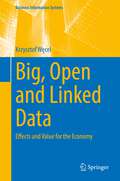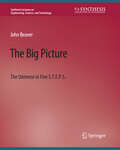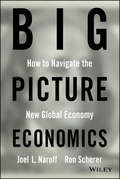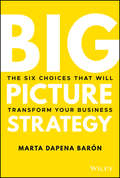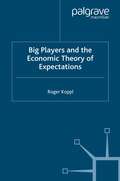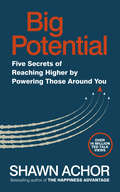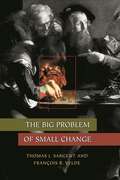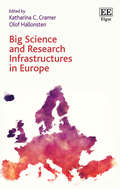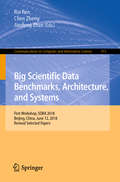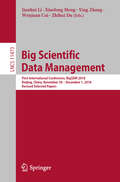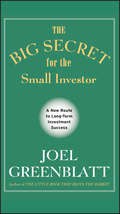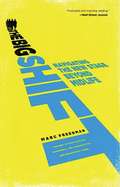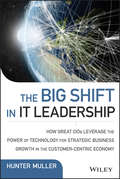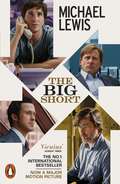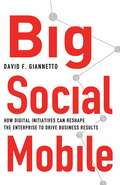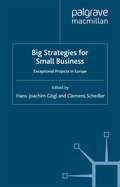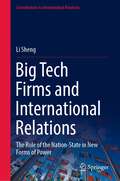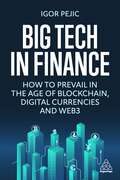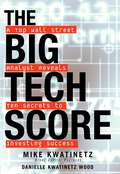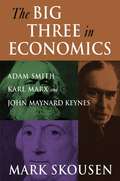- Table View
- List View
Big, Open and Linked Data: Effects and Value for the Economy (Business Information Systems)
by Krzysztof WęcelThis book examines the recent evolution of the concept of data as an economic and managerial phenomenon. The author first describes and discusses open data and then introduces the concept of linked data, with a focus on assets for reuse. Furthermore, he addresses the main challenges of big data. Value is identified as the main incentive for the adoption of linked data; accordingly, the next two chapters study sources of data value from a macroeconomic and micro economic perspective, respectively. This contributes to the systematization of important issues at the crossroads of enterprise data and data sharing: data ownership, personal data, and data privacy. In turn, the book reveals the role of innovation as a main vehicle for creating value by unifying big, open, and linked data. It studies the ways in which value can be created, transferred, and captured in the form of business models, before the closing chapter verifies the data unification model by combining open and linked geographical data with big data from a major telecom company.
The Big Picture: The Universe in Five S.T.E.P.S. (Synthesis Lectures on Engineering, Science, and Technology)
by John BeaverA brief overview of astronomy and cosmology is presented in five different ways, through the lenses of space, time, evolution, process, and structure. Specific topics are chosen for their contribution to a "big picture" understanding of the interconnectedness of knowledge in astronomy and cosmology. Thus, many topics (stellar astronomy for example) are treated in multiple sections, but from different viewpoints—for example, sizes and distances of stars (space); when stars appeared in the history of the universe (time); stellar evolution (evolution); hydrostatic equilibrium and stellar spectra (process); and stellar structure (structure). Some topics traditional to the introductory astronomy curriculum—eclipses and lunar phases, for example—are omitted altogether as they are inessential for the big-picture goals of the book, and excellent summaries are easily available elsewhere. On the other hand, the book treats some topics not usually covered in an introductory astronomy course, for example the roles played by equilibrium processes and symmetry in our understanding of the universe. The level is for the beginning undergraduate, with only basic skills in rudimentary algebra assumed. But more advanced students and teachers will also find the book useful as both a set of practical tools and a point of departure for taking stock (in five different ways) of the current state of knowledge in astronomy and cosmology.
Big Picture Economics: How to Navigate the New Global Economy
by Joel Naroff Ron SchererNavigate the economy with this insightful new book The world is awash with economic information. Governments release reports. Pundits give their interpretation on television. And the stock market may go its own way, confusing everyone. How can you better understand what it means for you? Big Picture Economics, a new book by award-winning columnist and futurist Joel Naroff and veteran journalist Ron Scherer, says the thread that ties everything together is "context." The authors show how consumers, business, the Federal Reserve, and government take into account what's going on around them to make critical decisions like buying new products, building new factories, changing interest rates, or setting budget goals. The book provides a clear roadmap to understanding the whole story behind the global economy. Big Picture Economics helps readers understand how context impacts decisions and decision makers. - The Federal Reserve and Congress in formulating economic policy - Consumers in a shopper nation and what makes us buy or not buy - Corporations making decisions on whether to build new factories and buy other companies - The federal budget that must deal with complex issues, including the reduction of health care spending - A simple test for tax cuts or increases: will they help the economy grow? - Where to produce and where to sell in a global economy that is more like a Mobius strip than a flat world - International events that can ripple through the economy and ultimately affect workers in the Midwest - Technology, such as intelligent drones to wearable computers, are changing the future Experts laud the book for its perceptive insights: "It all sounds like common sense, but it is actually based on a close, expert reading of economic history and what that history implies for the future. Read this book to become a more educated judge of economic policy." —Robert Moffitt, Krieger-Eisenhower Professor of Economics at Johns Hopkins University "Naroff and Scherer show how seemingly unrelated things like an upgrade of the Panama Canal, a Tex-Mex restaurant's menu change, or how many Americans are overweight turn out to be intricately linked to our daily experiences. What brings the book to life is the authors' focus on these hidden interconnections." —Brendan Conway, blogger and columnist, Barron's
Big Picture Economics: How to Navigate the New Global Economy
by Joel Naroff Ron SchererNavigate the economy with this insightful new book The world is awash with economic information. Governments release reports. Pundits give their interpretation on television. And the stock market may go its own way, confusing everyone. How can you better understand what it means for you? Big Picture Economics, a new book by award-winning columnist and futurist Joel Naroff and veteran journalist Ron Scherer, says the thread that ties everything together is "context." The authors show how consumers, business, the Federal Reserve, and government take into account what's going on around them to make critical decisions like buying new products, building new factories, changing interest rates, or setting budget goals. The book provides a clear roadmap to understanding the whole story behind the global economy. Big Picture Economics helps readers understand how context impacts decisions and decision makers. - The Federal Reserve and Congress in formulating economic policy - Consumers in a shopper nation and what makes us buy or not buy - Corporations making decisions on whether to build new factories and buy other companies - The federal budget that must deal with complex issues, including the reduction of health care spending - A simple test for tax cuts or increases: will they help the economy grow? - Where to produce and where to sell in a global economy that is more like a Mobius strip than a flat world - International events that can ripple through the economy and ultimately affect workers in the Midwest - Technology, such as intelligent drones to wearable computers, are changing the future Experts laud the book for its perceptive insights: "It all sounds like common sense, but it is actually based on a close, expert reading of economic history and what that history implies for the future. Read this book to become a more educated judge of economic policy." —Robert Moffitt, Krieger-Eisenhower Professor of Economics at Johns Hopkins University "Naroff and Scherer show how seemingly unrelated things like an upgrade of the Panama Canal, a Tex-Mex restaurant's menu change, or how many Americans are overweight turn out to be intricately linked to our daily experiences. What brings the book to life is the authors' focus on these hidden interconnections." —Brendan Conway, blogger and columnist, Barron's
Big Picture Strategy: The Six Choices That Will Transform Your Business
by Marta Dapena-BaronFOCUS YOUR TEAM, YOUR STRATEGY, AND YOUR COMPANY WITH AN INTEGRATED FRAMEWORK FOR GROWTH Regardless of the size and market strength of your firm, your resources and capabilities are ultimately limited. It is by concentrating these resources that you can magnify your company’s core competencies and find a strategic competitive advantage. While it’s hard to resist the siren song of consultants who suggest complex and multi-faceted approaches, Marta Dapena Barón makes a compelling argument for constraining your commercial choices as the best method to unlock growth. You’ll discover how to address the six fundamental questions that determine the success of any commercial endeavor. You’ll also learn how to tightly integrate your strategic planning with tactical execution, coordinating cross-functional teams through simple and effective operational benchmarks. The accessible advice in Big Picture Strategy will improve your organization’s ability to learn from its strategy-to-execution efforts, drive customer retention and loyalty, increase your marketing efficiency and efficacy, and differentiate your brand. Ideal for business leaders seeking an actionable and effective approach to commercial strategy that delivers results, this book is your roadmap to simplifying and focusing your approach to commercial success.
Big Picture Strategy: The Six Choices That Will Transform Your Business
by Marta Dapena-BaronFOCUS YOUR TEAM, YOUR STRATEGY, AND YOUR COMPANY WITH AN INTEGRATED FRAMEWORK FOR GROWTH Regardless of the size and market strength of your firm, your resources and capabilities are ultimately limited. It is by concentrating these resources that you can magnify your company’s core competencies and find a strategic competitive advantage. While it’s hard to resist the siren song of consultants who suggest complex and multi-faceted approaches, Marta Dapena Barón makes a compelling argument for constraining your commercial choices as the best method to unlock growth. You’ll discover how to address the six fundamental questions that determine the success of any commercial endeavor. You’ll also learn how to tightly integrate your strategic planning with tactical execution, coordinating cross-functional teams through simple and effective operational benchmarks. The accessible advice in Big Picture Strategy will improve your organization’s ability to learn from its strategy-to-execution efforts, drive customer retention and loyalty, increase your marketing efficiency and efficacy, and differentiate your brand. Ideal for business leaders seeking an actionable and effective approach to commercial strategy that delivers results, this book is your roadmap to simplifying and focusing your approach to commercial success.
Big Players and the Economic Theory of Expectations
by R. KopplInvestment and all other economic actions depend on 'subjective' expectations. The problem is how to construct a theory of expectations that assumes people interpret their situations in unpredictable ways. Building on the evolutionary economics of F.A.Hayek, Koppl gives us such a theory. This includes a theory of 'Big Players', demonstrating that discretionary policy interventions create ignorance and uncertainty. The volume uses innovative methods to address many vital problems in economic theory, and connects with many other schools of economics including New Institutional Economics, Constitutional Economics and Post Walsarian Economics.
Big Potential: Five Secrets of Reaching Higher by Powering Those Around You
by Shawn AchorForget everything you thought you knew about being your best. It’s not about your own skills or talents. Instead, real success in work and life comes from your connections and relationships – the teams you build around you, the friends you make – and getting the best out of them. You hugely amplify your own potential by helping others around you to realise theirs.A TED talk star with over 16 million views, Shawn Achor is one of the world’s leading experts on happiness and personal success – and author of the positive psychology classic The Happiness Advantage. Now, in this game-changing guide to greatness, he demolishes the myth of single individual achievement. With powerful stories, cutting-edge research and exclusive insights from Fortune 100 leaders, he shows how only by working with others will you ever reach your Big Potential.
The Big Problem of Small Change
by Thomas J. Sargent François R. VeldeThe Big Problem of Small Change offers the first credible and analytically sound explanation of how a problem that dogged monetary authorities for hundreds of years was finally solved. Two leading economists, Thomas Sargent and François Velde, examine the evolution of Western European economies through the lens of one of the classic problems of monetary history--the recurring scarcity and depreciation of small change. Through penetrating and clearly worded analysis, they tell the story of how monetary technologies, doctrines, and practices evolved from 1300 to 1850; of how the "standard formula" was devised to address an age-old dilemma without causing inflation. One big problem had long plagued commodity money (that is, money literally worth its weight in gold): governments were hard-pressed to provide a steady supply of small change because of its high costs of production. The ensuing shortages hampered trade and, paradoxically, resulted in inflation and depreciation of small change. After centuries of technological progress that limited counterfeiting, in the nineteenth century governments replaced the small change in use until then with fiat money (money not literally equal to the value claimed for it)--ensuring a secure flow of small change. But this was not all. By solving this problem, suggest Sargent and Velde, modern European states laid the intellectual and practical basis for the diverse forms of money that make the world go round today. This keenly argued, richly imaginative, and attractively illustrated study presents a comprehensive history and theory of small change. The authors skillfully convey the intuition that underlies their rigorous analysis. All those intrigued by monetary history will recognize this book for the standard that it is.
The Big Problem of Small Change
by Thomas J. Sargent François R. VeldeThe Big Problem of Small Change offers the first credible and analytically sound explanation of how a problem that dogged monetary authorities for hundreds of years was finally solved. Two leading economists, Thomas Sargent and François Velde, examine the evolution of Western European economies through the lens of one of the classic problems of monetary history--the recurring scarcity and depreciation of small change. Through penetrating and clearly worded analysis, they tell the story of how monetary technologies, doctrines, and practices evolved from 1300 to 1850; of how the "standard formula" was devised to address an age-old dilemma without causing inflation. One big problem had long plagued commodity money (that is, money literally worth its weight in gold): governments were hard-pressed to provide a steady supply of small change because of its high costs of production. The ensuing shortages hampered trade and, paradoxically, resulted in inflation and depreciation of small change. After centuries of technological progress that limited counterfeiting, in the nineteenth century governments replaced the small change in use until then with fiat money (money not literally equal to the value claimed for it)--ensuring a secure flow of small change. But this was not all. By solving this problem, suggest Sargent and Velde, modern European states laid the intellectual and practical basis for the diverse forms of money that make the world go round today. This keenly argued, richly imaginative, and attractively illustrated study presents a comprehensive history and theory of small change. The authors skillfully convey the intuition that underlies their rigorous analysis. All those intrigued by monetary history will recognize this book for the standard that it is.
Big Science and Research Infrastructures in Europe
This thought-provoking book expands on the notion that Big Science is not the only term to describe and investigate particularly large research projects, scientific collaborations and facilities. It investigates the significant overlap between Big Science and Research Infrastructures (RIs) in a European context since the early twenty-first century. Contributions to this innovative book not only augment the study of Big Science with new perspectives, but also launch the study of RIs as a promising new line of inquiry. Chapters testify to a generational shift that is taking place in this field, amending and complementing prior analyses of Big Science. Advancing our knowledge, this interdisciplinary book explores how Big Science and RIs can be categorized, how the politics around them can be understood, and how they relate to the surrounding science and research policy landscape of Europe. Big Science and Research Infrastructures in Europe will be of value to students and scholars interested in science and innovation policy across sociology, economics, management and political science. Policymakers, science administrators and operators of RIs will also benefit from the critical insights provided.
Big Scientific Data Benchmarks, Architecture, and Systems: First Workshop, SDBA 2018, Beijing, China, June 12, 2018, Revised Selected Papers (Communications in Computer and Information Science #911)
by Rui Ren Chen Zheng Jianfeng ZhanThis book constitutes the refereed proceedings of the First Workshop on Big Scientific Data Benchmarks, Architecture, and Systems, SDBA 2018, held in Beijing, China, in June 2018.The 10 revised full papers presented were carefully reviewed and selected from 22 submissions. The papers are organized in topical sections on benchmarking; performance optimization; algorithms; big science data framework.
Big Scientific Data Management: First International Conference, BigSDM 2018, Beijing, China, November 30 – December 1, 2018, Revised Selected Papers (Lecture Notes in Computer Science #11473)
by Jianhui Li Xiaofeng Meng Ying Zhang Wenjuan Cui Zhihui DuThis book constitutes the refereed proceedings of the First International Conference on Big Scientific Data Management, BigSDM 2018, held in Beijing, Greece, in November/December 2018. The 24 full papers presented together with 7 short papers were carefully reviewed and selected from 86 submissions. The topics involved application cases in the big scientific data management, paradigms for enhancing scientific discovery through big data, data management challenges posed by big scientific data, machine learning methods to facilitate scientific discovery, science platforms and storage systems for large scale scientific applications, data cleansing and quality assurance of science data, and data policies.
The Big Secret for the Small Investor: A New Route to Long-Term Investment Success
by Joel GreenblattAcclaim for Joel Greenblatt's New York Times bestseller THE LITTLE BOOK THAT BEATS THE MARKET "One of the best, clearest guides to value investing out there." —Wall Street Journal "Simply perfect. One of the most important investment books of the last fifty years!" —Michael Price "A landmark book-a stunningly simple and low-risk way to significantly beat the market!" —Michael Steinhardt, the dean of Wall Street hedge-fund managers "The best book on the subject in years." —Financial Times "The best thing about this book-from which I intend to steal liberally for the next edition of The Only Investment Guide You'll Ever Need-is that most people won't believe it. . . . That's good, because the more people who know about a good thing, the more expensive that thing ordinarily becomes. . . ." —Andrew Tobias, author of The Only Investment Guide You'll Ever Need "This book is the finest simple distillation of modern value investing principles ever written. It should be mandatory reading for all serious investors from the fourth grade on up." —Professor Bruce Greenwald, director of the Heilbrunn Center for Graham and Dodd Investing, Columbia Business School
The Big Secret for the Small Investor: A New Route to Long-Term Investment Success
by Joel GreenblattAcclaim for Joel Greenblatt's New York Times bestseller THE LITTLE BOOK THAT BEATS THE MARKET "One of the best, clearest guides to value investing out there." —Wall Street Journal "Simply perfect. One of the most important investment books of the last fifty years!" —Michael Price "A landmark book-a stunningly simple and low-risk way to significantly beat the market!" —Michael Steinhardt, the dean of Wall Street hedge-fund managers "The best book on the subject in years." —Financial Times "The best thing about this book-from which I intend to steal liberally for the next edition of The Only Investment Guide You'll Ever Need-is that most people won't believe it. . . . That's good, because the more people who know about a good thing, the more expensive that thing ordinarily becomes. . . ." —Andrew Tobias, author of The Only Investment Guide You'll Ever Need "This book is the finest simple distillation of modern value investing principles ever written. It should be mandatory reading for all serious investors from the fourth grade on up." —Professor Bruce Greenwald, director of the Heilbrunn Center for Graham and Dodd Investing, Columbia Business School
The Big Shift: Navigating the New Stage Beyond Midlife
by Marc FreedmanMarc Freedman, hailed by the New York Times as "the voice of aging baby boomers [seeking] meaningful and sustaining work later in life,” offers a recipe for how we can transform America's coming midlife crisis into a midlife opportunity. Millions of people in their fifties, sixties, and seventies are searching for answers to the question "What's next?” and are navigating their way to an entirely new stage of life and work, one that could last as long as midlife. Shifting to a much longer lifespan isn't as easy as it may seem. Unlike the transition from adolescence to adulthood, managing this process for many is a do-it-yourself project. Drawing on powerful personal stories, The Big Shift provides not only direction but a vision of what it would take to help millions find their footing in a new map of life.
The Big Shift in IT Leadership: How Great CIOs Leverage the Power of Technology for Strategic Business Growth in the Customer-Centric Economy (Wiley CIO)
by Hunter MullerLearn the unique leadership strategies of the effective, essential CIO Beyond the Cloud provides a blueprint for leadership in an era of high volatility, rapid transformation, and amazing growth. An effective CIO is essential to the successful navigation of turbulent and uncertain times, and this insightful guide gives you the actionable framework you need to execute the leadership strategies that work. Focused on the major factors that are critical to modern global enterprise, this book delves into communication, collaboration, relationships, technology, innovation, talent management, and more to provide well-rounded guidance toward principled leadership. Simple, straightforward language explains the basics of each area, and is expanded upon by real-world stories and revealing anecdotes gathered from the author's exclusive interviews with visionary thought leaders from major organizations worldwide. You get perspective from the top on established and emerging leadership strategies, helping you put these ideas to work right away. CIOs are perfectly positioned to provide the leadership required to stay ahead of the competition in complex, rapidly shifting markets. They break down walls, align resources, and facilitate collaboration to drive business value and spur growth amidst an atmosphere of hyper-competition. This guide is your practical handbook for becoming the leader that you need to be. Establish trust and cooperation across the enterprise Recruit and retain the top talent in your field Leverage new technology for continuous business growth Inspire loyalty and optimal performance from everyone on the team The CIO has never been more crucial to the enterprise than right now. With clear guidance toward the unique leadership skills the role requires, Beyond the Cloud is the foundational executive guide for transformational leaders in the new business era.
The Big Shift in IT Leadership: How Great CIOs Leverage the Power of Technology for Strategic Business Growth in the Customer-Centric Economy (Wiley CIO)
by Hunter MullerLearn the unique leadership strategies of the effective, essential CIO Beyond the Cloud provides a blueprint for leadership in an era of high volatility, rapid transformation, and amazing growth. An effective CIO is essential to the successful navigation of turbulent and uncertain times, and this insightful guide gives you the actionable framework you need to execute the leadership strategies that work. Focused on the major factors that are critical to modern global enterprise, this book delves into communication, collaboration, relationships, technology, innovation, talent management, and more to provide well-rounded guidance toward principled leadership. Simple, straightforward language explains the basics of each area, and is expanded upon by real-world stories and revealing anecdotes gathered from the author's exclusive interviews with visionary thought leaders from major organizations worldwide. You get perspective from the top on established and emerging leadership strategies, helping you put these ideas to work right away. CIOs are perfectly positioned to provide the leadership required to stay ahead of the competition in complex, rapidly shifting markets. They break down walls, align resources, and facilitate collaboration to drive business value and spur growth amidst an atmosphere of hyper-competition. This guide is your practical handbook for becoming the leader that you need to be. Establish trust and cooperation across the enterprise Recruit and retain the top talent in your field Leverage new technology for continuous business growth Inspire loyalty and optimal performance from everyone on the team The CIO has never been more crucial to the enterprise than right now. With clear guidance toward the unique leadership skills the role requires, Beyond the Cloud is the foundational executive guide for transformational leaders in the new business era.
The Big Short: Inside the Doomsday Machine (Movie Tie-in Editions Ser.)
by Michael LewisTHE OUTRAGEOUS NO.1 INTERNATIONAL BESTSELLER, NOW AN OSCAR- AND BAFTA-WINNING FILM From the jungles of the trading floor to the casinos of Las Vegas, The Big Short, Michael Lewis's No.1 bestseller, tells the story of the misfits, renegades and visionaries who saw that the biggest credit bubble of all time was about to burst, bet against the banking system - and made a killing. 'In the hands of Michael Lewis, anything is possible ... if you want to know how a nation lost its financial mind - and have a good laugh finding out - this is the book to read' Sunday Times 'Magnificent ... a perfect storm of brilliant writer meeting big subject' Guardian 'A triumph ... riveting ... The Big Short reads like a thriller' The Times'A terrifying story, superbly well told' Daily Telegraph'A rollicking good yarn' Financial Times 'Probably the single best piece of financial journalism ever written' Reuters
Big Social Mobile: How Digital Initiatives Can Reshape the Enterprise and Drive Business Results
by D. GiannettoBig Social Mobile shows that big data, along with social and mobile media, can improve enterprise performance significantly, but only when implemented in a holistic fashion. This book offers an integrative process that has helped a wide range of businesses enhance what has traditionally made them unique, resulting in transformative results.
Big Strategies for Small Business: Exceptional Projects in Europe
by H. Gögl C. SchedlerA new look at models of cooperation for trades of the future. Using seven in-depth case studies, this book looks at how globalization affects the competitiveness of small businesses. It explores the opportunities that are open to them today, and the successful strategies and models that promote development.
Big Tech Firms and International Relations: The Role of the Nation-State in New Forms of Power (Contributions to International Relations)
by Li ShengThis book presents cutting-edge research and exploration of the role of nation-state when big tech firms present themselves as new participants in contemporary international relations that act on an equal footing with nation-states. The general research goal of this book is to identify the justifications that nation-states have adopted to regulate the big tech firms and the impacts of this process on international trade in the main economies in the world. With the massive instrumentation of data, big tech firms have become actors with the capacity to intervene not only in economies but also, above all, in the politics of different countries with different systems. The emergence of big tech firms has transformed the approach to the concepts of national security, information management and access to new technologies among nation-states. The principles and fundamentals of cyber sovereignty have become one of the bases of states in the contemporary system of international relations. Today, the influence of big tech firms in different societies in the contemporary world is one of the main forms of power. This book tries to collect and present the recent state of the art in studies on the relationship between big tech firms and nation-states in the literature. It also addresses how governments such as those of the US, China and the EU are changing their legislation, creating control and data security mechanisms, imposing entry restrictions on foreign companies, and regulating the actions beyond the cloud of big tech firms inside and outside their borders.
Big Tech in Finance: How To Prevail In the Age of Blockchain, Digital Currencies and Web3
by Igor PejicWith Big Tech's breakthrough into finance with blockchain, it is imperative that finance players understand the ramifications and how they can defend their competitive advantage.Big Tech in Finance provides a cutting edge look at Big Tech's play for domination of the crypto economy, its ramifications and how finance is fighting back. The book analyses the motives behind Big Tech's break into banking and unpicks the strategies behind the use of blockchain, technology interfaces, infrastructure and investments into blockchain unicorns. The book then goes onto review how organizations in finance are countering these threats, with governments and banks driving their own strategies and use of centralized blockchains. Delving into the fight between Big Tech, Big Banking, start-ups, and regulators, Big Tech in Finance analyzes which actors have the best shot at succeeding. It explores the key tools in play, such as smart contracts, digital central bank currencies, decentralized autonomous organizations (DAOs) and the metaverse. The book also divulges the geopolitical dimensions underpinning the power struggle and its implications for the industry. Written by an internationally recognized expert on blockchain, the book draws on in-depth interviews with founders, investors, regulators, bankers and blockchain experts to provide valuable insider insights. This will be an essential read for finance and fintech professionals, bankers and investors and anyone else interested in the developments of fintech.
The Big Tech Score: A Top Wall Street Analyst Reveals Ten Secrets to Investing Success
by Mike Kwatinetz Danielle Kwatinetz WoodInsights for today's hot stocks, and winning strategies fortomorrow's, from Wall Street's #1 Tech Analyst This is not your grandpa's Wall Street. Stocks are more volatilenow than ever. Even with all their potential for meteoric success,high tech investments are synonymous with high risk. Thisentertaining primer, by one of the leading tech analysts on WallStreet, offers a practical step-by-step guide for identifyingtomorrow's hot stocks today. Why do certain technology companies succeed while others falter anddisappear? Which businesses will rule the post-PC era? Kwatinetzdiscusses what's coming down the pike in the next few years and whothe key players will be. He shows how to filter out the noise, and come up with anindependent assessment of how much a stock is worth, and revealsten rules of thumb that will help investors build a powerfulportfolio.
The Big Three in Economics: Adam Smith, Karl Marx, and John Maynard Keynes
by Mark SkousenHistory comes alive in this fascinating story of opposing views that continue to play a fundamental role in today's politics and economics. "The Big Three in Economics" traces the turbulent lives and battle of ideas of the three most influential economists in world history: Adam Smith, representing laissez faire; Karl Marx, reflecting the radical socialist model; and John Maynard Keynes, symbolizing big government and the welfare state. Each view has had a significant influence on shaping the modern world, and the book traces the development of each philosophy through the eyes of its creator. In the twenty-first century, Adam Smith's "invisible hand" model has gained the upper hand, and capitalism appears to have won the battle of ideas over socialism and interventionism. But author Mark Skousen shows that, even in the era of globalization and privatization, Keynesian and Marxian ideas continue to play a significant role in economic policy.
